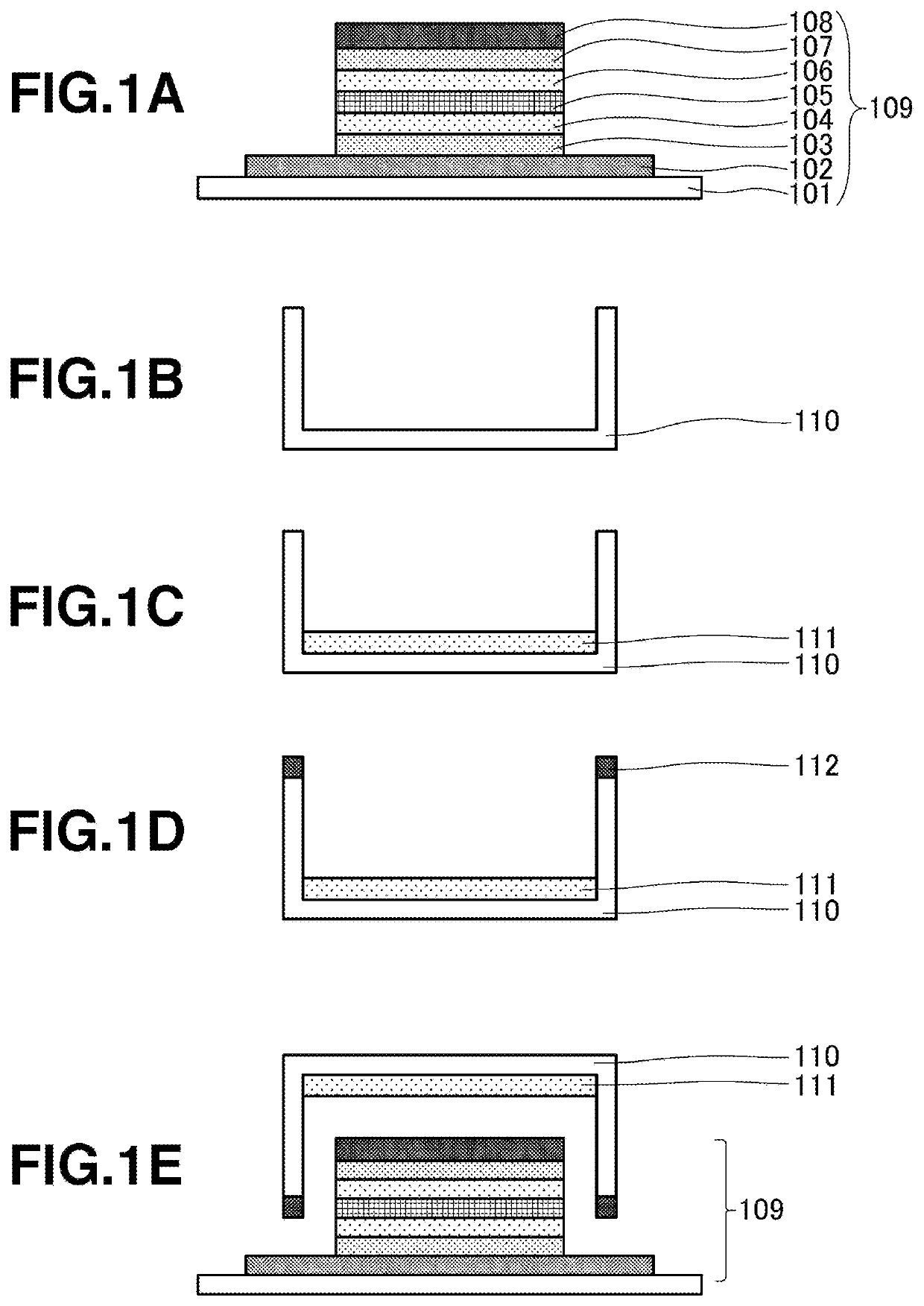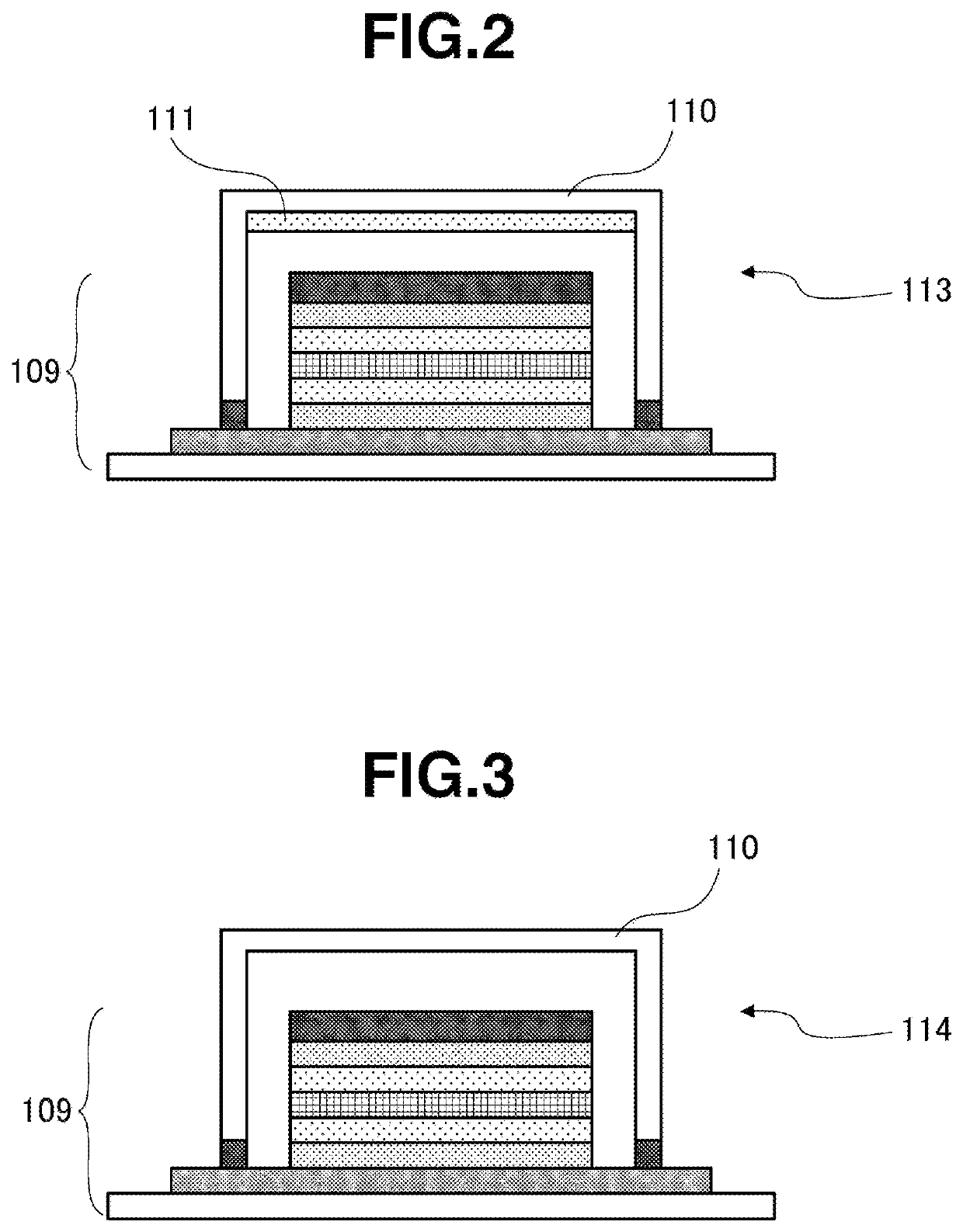Transparent desiccant for organic EL, and method for using same
a desiccant and organic el technology, applied in the field of desiccant for organic electroluminescent devices, to achieve the effect of suppressing the degradation of organic el elements, high transparency, and small shrinkage of pixels
- Summary
- Abstract
- Description
- Claims
- Application Information
AI Technical Summary
Benefits of technology
Problems solved by technology
Method used
Image
Examples
preparation example 1
[Preparation of Organopolysiloxane Composition 1]
[0065]Thirty parts of a dimethylpolysiloxane capped at both ends with Me2ViSiO1 / 2 units (weight-average molecular weight, 1,000) and 70 parts of a dimethylpolysiloxane capped at both ends with Me2ViSiO1 / 2 units (weight-average molecular weight, 5,000) were used as Component (A), and organohydrogenpolysiloxanes of the following average formula
H1.29Me0.72SiO1.98 / 2
wherein the number of moles of silicon-bonded hydrogen atoms per unit weight Y (mol / g) relative to the number of moles of silicon-bonded vinyl groups per unit weight X (mol / g) in component (A) satisfies formulas (1) to (3) below
Y−X=0.06 mol / g (1)
Y−X=0.6 mol / g (2)
Y−X=1.3 mol / g (3)
were each prepared as component (B).
[0066]In addition, 0.1 part of a 1,1-divinyltetramethyldisiloxane complex solution of chloroplatinic acid (1 wt %, based on elemental platinum) was used as component (C) and 0.03 part of 1-ethynyl-1-cyclohexanol was used as the hydrosilylation reaction regulator, ...
preparation example 2
[Preparation of Organopolysiloxane Composition 2]
[0067]In the organopolysiloxane serving as component (A), components (A-1) and (A-2) below:
(A-1) a resinous organopolysiloxane having at least two alkenyl groups per molecule, and
(A-2) a linear organopolysiloxane having at least two alkenyl groups per molecule were each prepared such that the sum of (A-1) and (A-2) was 100 wt % and to the following ratios (i) and (ii).
[0068](i) (A-1):(A-2)=1:99
[0069](ii) (A-1):(A-2)=50:50
[0070]Specifically, 49.0 parts of a resinous organopolysiloxane consisting of 6.8 mol % of Me2ViSiO1 / 2 units, 39.8 mol % of Me3SiO1 / 2 units and 53.4 mol % of SiO4 / 2 units (weight-average molecular weight=6,000: Composition a) and 1.0 part of a resinous organopolysiloxane consisting of 50 mol % of Me2ViSiO1 / 2 units and 50 mol % of MeSiO3 / 2 units (weight-average molecular weight=5.000: Composition b) were used as component (A-1), and 15 parts of a dimethylpolysiloxane capped at both ends with Me2ViSiO1 / 2 units (weight-a...
example 1
[0076]The organopolysiloxane composition was prepared as described in Preparation Example 1, with preparation being carried out such that the number of moles of silicon-bonded hydrogen atoms per unit weight Y (mol / g) in the organohydrogenpolysiloxane relative to the number of moles of silicon-bonded vinyl groups per unit weight X (mol / g) in component (A) satisfies the following formula
Y−X=0.06 mol / g.
[0077]The resulting organopolysiloxane composition was disposed within the organic EL panel by the procedure described in the above organic EL panel fabrication process, thereby giving the organic EL panel (113) shown in FIG. 2 having a transparent desiccant attached therein. The amount of organopolysiloxane composition added by dripping within the organic EL panel was set to 0.043 g (an amount corresponding to a thickness of 30 μm).
PUM
| Property | Measurement | Unit |
|---|---|---|
| thickness | aaaaa | aaaaa |
| temperature | aaaaa | aaaaa |
| temperature | aaaaa | aaaaa |
Abstract
Description
Claims
Application Information
 Login to View More
Login to View More - R&D
- Intellectual Property
- Life Sciences
- Materials
- Tech Scout
- Unparalleled Data Quality
- Higher Quality Content
- 60% Fewer Hallucinations
Browse by: Latest US Patents, China's latest patents, Technical Efficacy Thesaurus, Application Domain, Technology Topic, Popular Technical Reports.
© 2025 PatSnap. All rights reserved.Legal|Privacy policy|Modern Slavery Act Transparency Statement|Sitemap|About US| Contact US: help@patsnap.com


